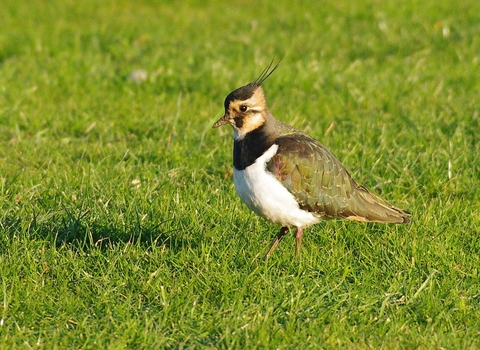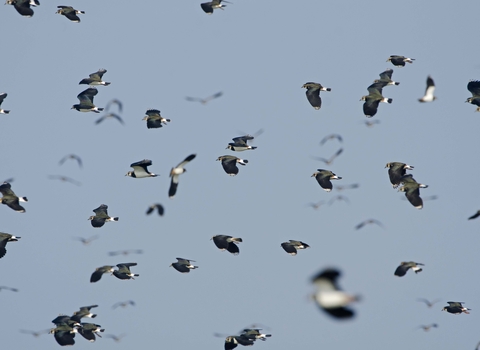
©Gillian Day

©David Tipling/2020VISION
Lapwing
The distinctive rounded wings of the lapwing are displayed beautifully when it wheels around a winter sky in a massive flock. In spring, these flocks disperse and some birds breed in the UK. Listen out for their 'peewit' calls on grasslands and wetlands.
Scientific name
Vanellus vanellusWhen to see
January to DecemberSpecies information
Category
Statistics
Length: 28-31cmWingspan: 84cm
Weight: 230g
Average lifespan: 4 years
Classified in the UK as Red under the Birds of Conservation Concern 5: the Red List for Birds (2021). Priority Species under the UK Post-2010 Biodiversity Framework. Listed as Near Threatened on the global IUCN Red List of Threatened Species.
About
Familiar birds of farmlands and wetlands, lapwings can often be seen wheeling through winter skies in large, black and white flocks. As spring approaches, these flocks get smaller; some birds head back to their continental breeding grounds and others disperse to breed in the UK. Males put on dramatic aerial displays, tumbling through the air, accompanied by their piercing 'peewit' call, which gives them their other, common name: peewit. Females can be spotted on their nests, which are simple scrapes in the mud or sand. By late spring, cute, fluffy lapwing chicks can be seen venturing out to forage. If the nest is threatened at all, the parents will attacked or 'mob' the potential predators.How to identify
Lapwings can be recognised by their long crests, black and white patterns, and very broad, round wingtips. From a distance, lapwings look black and white, but up-close, the back has an iridescent green and purple sheen.Distribution
Widespread, particularly in lowland areas.Did you know?
As well as 'lapwing' and 'peewit', this bird is also known locally as the 'green plover'. Its Latin, Vanellus, means 'little fan' and actually refers to its floppy, flapping flight. The name lapwing is thought to derive from an Old English term meaning 'leap with a flicker in it' because the dense winter flocks appear to flicker between white and black when the birds flap their wings.Watch
Lapwing (https://vimeo.com/447453572)
Lapwing by Tom Hibbert
